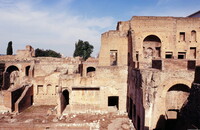| dc.coverage.spatial | Site: Rome, Lazio, Italy | en_US |
| dc.coverage.temporal | 1994 (creation) | en_US |
| dc.creator | Gilchrist, Scott | en_US |
| dc.date | 1994 | en_US |
| dc.date.accessioned | 2013-02-25T17:51:41Z | |
| dc.date.available | 2013-02-25T17:51:41Z | |
| dc.date.issued | 1994 | en_US |
| dc.identifier | 196092 | en_US |
| dc.identifier.other | archrefid: 1537 | en_US |
| dc.identifier.uri | http://hdl.handle.net/1721.3/103589 | |
| dc.description | Domus Augustana, south peristyle, frontal view of the north side of the peristyle; The Palatine Hill (Latin: Collis Palatium or Mons Palatinus) is the centermost of the Seven Hills of Rome and is one of the most ancient parts of the city. It stands 40 metres above the Forum Romanum, looking down upon it on one side, and upon the Circus Maximus on the other. It is the etymological origin of the word "palace". Source: Wikipedia; http://en.wikipedia.org/wiki/Main_Page (accessed 7/12/2008) | en_US |
| dc.rights | © Scott Gilchrist, Archivision, Inc. | en_US |
| dc.subject | cityscapes | en_US |
| dc.subject | City planning | en_US |
| dc.subject | Roman Empire | en_US |
| dc.subject | Twentieth century | en_US |
| dc.title | Palatine Hill: Topographic Views | en_US |
| dc.type | image | en_US |
| dc.rights.access | Licensed for educational and research use by the MIT community only | en_US |
| dc.identifier.vendorcode | 1A3-R-R-P-F1 | en_US |
| vra.culturalContext | Ancient Roman | en_US |
| vra.technique | photography | en_US |
| vra.worktype | topographical view | en_US |
| vra.worktype | photograph | en_US |
| dc.contributor.display | Scott Gilchrist (Canadian photographer, born 1960) | en_US |


